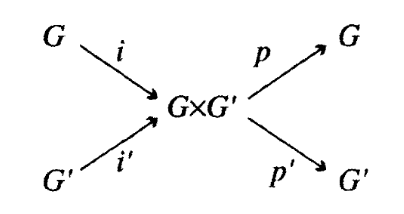Third isomorphism theorem
Theorem 1(Third Isomorphism Theorem).
Let be a group and let , , and . Then, and
Proof
First, observe that and implies . So, is a group.
Consider , .Since is a normal subgroup, . Thus, . Since conjugation is an invertible operation, this gives , i.e. .
Now, consider the map defined by . This map is well defined, since if is in a coset , is also necessarily in . is also surjective, since for every , .
is an homomorphism: , . The kernel of is the set of all cosets of contained in , .
From the first isomorphism theorem, .
Note that if only , , and are true, we can still define as we did above, but as a set theoretic function. Note that and are only sets of cosets here, not groups. Our reasoning that is well defined did not use the normality of or , and thus is still valid.
Direct products
Definition 2.
Let and be two groups. The product set , the set of pairs of elements with in and in , can be made into a group, known as the product group, by component wise multiplication:
The pair is the identity, and the inverse of is . The associative law in follows from the fact that it holds in and .
The group is related to and by inclusion and projection maps:

Here, is the inclusion map and is the projection map . Ditto for and .
Theorem 3(Proposition).
when .
Proof generates , and has order .
Recognizing direct products
Theorem 4.
Let and be subgroups of a group , and let be the multiplication map, defined by . Its image is the set .
- is injective iff .
- is a homomorphism iff elements of commute with elements of .
- iff . Useful to note here that
- .
- In particular, if , for all .
- is an isomorphism iff , , , and .
Warning
Note that does not imply that the elements of commute with the elements of . Also, 3.1 is not a two way implication.
Proof of 1
Let . Then, . Notice that since and , it must be that both are equal to . Thus, and .
On the other hand, if , , we have and , making not injective.Proof of 2
Proof of 3
3.1 and 3.2 should be obvious. Given , is closed under multiplication, since . Also, is in . The reverse implication is also easy to prove.Proof of 4
The first two conditions ensure is injective and surjective, making it bijective. According to , is a homomorphism iff for all and . Consider the commutator . Since is normal, the left side is in , and since is normal, the right side is in . Knowing that , we get .
Theorem 5(Proposition).
Proof
Notice that is a union of a subset of the left cosets of :Since each coset of had elements, it suffices to find the number of distinct cosets of the form , . But, . Thus, and belong to the same coset of if and only if they also belong to the same coset of . Thus, the number of distinct cosets of the form is equal to the index of in . Thus,
Example: Chinese remainder theorem
Theorem 6(Chinese remainder theorem).
If positive integers and are co-prime,
Proof
Consider the map
defined by
Showing that is well defined and is a homomorphism
To check that is well defined, let . Then, , i.e. for some . This can be rewritten an , so, . Thus, . Similarly, .
is an homomorphism:
Establishing that
The kernel of is given by
For the forward implication, since the size of the domain and codomain are equal, we only have to show either surjectivity or injectivity to have bijectivity. We can show injectivity right here: if , .
Alternatively, we can first prove a more general result:
Establishing that
From the first isomorphism theorem,
the isomorphism being defined by . From the third isomorphism theorem,
with being defined by . Thus, , is an isomorphism.
We can now show surjectivity by noting that must be isomorphic to a subgroup of (which has order ) of order . If , the only subgroup can be isomorphic to is the entire codomain, making surjective, and hence an isomorphism.
… or you could proceed like Clare did. We have the exact sequence
where is injective (note that its codomain has been extended). We know that when and are co-prime, so let’s try to make an isomorphism. To achieve this, all we need to do is to make surjective. If we can construct another homomorphism in the sequence such that and such that , we will be done.
Define
by . (The notation here is a little misleading, so remember that is actually a product of two groups. It is a group since the multiplication map is a homomorphism. Since we are working with an abelian group, all subgroups are normal subgroups, so the quotient is defined).
To check is well defined, let . Then, and . It follows that
is a homomorphism:
Clearly, is surjective, since for all (this will be useful soon).
Now we will show that .
should be obvious. If , , i.e. . . Thus, .
Finally, we’ve got everything. If is an isomorphism, , so . Since is surjective, . This implies and generate , which implies or .
Conversely, if , then is the trivial group, and , making an isomorphism.